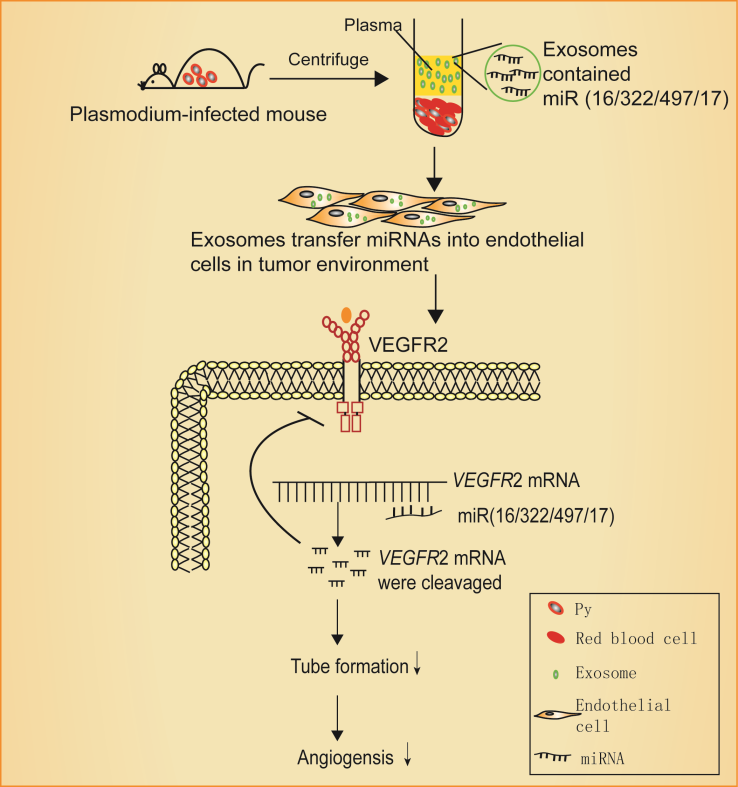Chinese Scientists Reveal A New Mechanism About Exosomes From Plasmodium-infected Hosts Inhibit Tumor Angiogenesis
A research group led by Prof. CHEN Xiaoping from the Guangzhou Institutes of Biomedicine and Health (GIBH) revealed a new mechanism about exosomes from Plasmodium-infected hosts inhibit tumor angiogenesis, which was newly published in international academic journal Oncogenesis online on June 26th.
Previously, Prof. Chen and his research group found that malaria infection provided anti-tumor effects by inducing both anti-angiogenic and potent anti-tumor immune responses in a murine Lewis lung cancer model. Exosomes, which are extracellular vesicles that function in intercellular communication, may play key roles in disseminating pathogenic host-derived molecules during infection. However, it is unknown whether the exosomes derived from Plasmodium-infected hosts inhibit tumor angiogenesis; therefore, researchers designed a murine Lewis lung cancer model study to address this question.
The first author Dr. YANG Yijun said that exosomes were isolated from the plasma of Plasmodium-infected mice. The researchers found that when co-cultured with endothelial cells, the exosomes markedly suppressed VEGFR2 expression and decreased endothelial cell migration. Intra-tumor injection of the exosomes significantly reduced Lewis lung cancer (LLC) growth in mice. Furthermore, researchers detected higher expression levels of the micro-RNA (miRNA) 16/322/497/17 in the exosomes derived from the plasma of Plasmodium-infected mice compared with those from control animals. They also observed that overexpression of the miRNA 16/322/497/17 in endothelial cells corresponded with decreased VEGFR2 expression and inhibition of angiogenesis in vitro, whereas inhibition of the miRNA 16/322/497/17 significantly alleviated these effects. These data provide a novel understanding of the interaction between Plasmodium infection and lung cancer.

Schematic of plasma exosomes from plasmodium-infected mice inhibition of angiogenesis through miR(16/322/497/17) to target VEGFR2.(Image by CHEN et al.)
Attachment Download:
-
Contact
-
Reference
-
Related ArticleChinese Scientists Demonstrated the Mechanism of How Heterochromatin Relaxer Gadd45a Opens Up Mirna During Pluripotency AcquirementNov 15, 2017On October 12 , Xingguo Liu ’ s laboratory at the Guangzhou Institutes of Biomedicine and Health ( GIBH ) .Chinese Academy of Sciences published an article online entitled “ Gadd45a opens up the promoters regions of miR-295 facilitating pluripotency induction ” in Nature publisher journal Cell Death and Disease . Scientists discovered that heterochromatin relaxer Gadd45a relaxes the promoter regions of miR-295 and increases the expression of miR-295 during reprogramming .Gadd45a activates miR-295 by relaxing its promoter regions during reprogramming.Chinese Scientists Reveal A New Mechanism About Exosomes From Plasmodium-infected Hosts Inhibit Tumor AngiogenesisJul 06, 2017A research group led by Prof . CHEN Xiaoping from the Guangzhou Institutes of Biomedicine and Health ( GIBH ) revealed a new mechanism about exosomes from Plasmodium-infected hosts inhibit tumor angiogenesis .Which was newly published in international academic journal Oncogenesis online on June 26th .Schematic of plasma exosomes from plasmodium-infected mice inhibition of angiogenesis through miR ( 16/322 / 497/17 ) to target VEGFR2 . ( Image by CHEN et al . ).Chinese Scientists discovered the rules for organelle remodeling during pluripotency acquirementAug 02, 2017Xingguo Liu ’ s lab at the Guangzhou Institutes of Biomedicine and Health ( GIBH ) published an article online entitled “ BNIP3L-dependent Mitophagy Accounts for Mitochondrial Clearance during Three Factors Induced Somatic Cell Reprogramming ” in Autophagy . Based on somatic cell reprogramming induced by SKO ( Sox2 .Researchers showed that the interorganellar interactions of endosome , autophagosome and mitochondria contribute to the organelle remodeling and functional shift during the generation of . induced pluripotent stem cells ( iPSCs ) .Pig Model of Huntington’s Offers Advantages for Testing TreatmentsMar 30, 2018Using genetic engineering technology , a team of scientists has established a pig model of Huntington ’ s disease ( HD ) , an inherited neurodegenerative disease .The researchers anticipate that the pigs could be a practical way to test treatments for HD , which is caused by a gene encoding a toxic protein that causes brain cells to die .The National Natural Science Foundation of China , and Guangdong Province .Scientists Develop a Method to Engineer Cell States With Artificial ProteinsAug 03, 2018In a study published in Stem Cell Reports , a research group of the Guangzhou Institutes of Biomedicine and Health introduces a screening platform to identify artificial proteins , boosting the generation of induced pluripotent stem cells .Therefore , different tissue samples - such as skin , blood , or urine , can be reprogrammed into a pluripotent state by culturing them in a dish and introducing cocktails of molecular switches , turning genes on or off .The article can be accessed online : http : / / www . cell . com/stem-cell-reports/fulltext/S.